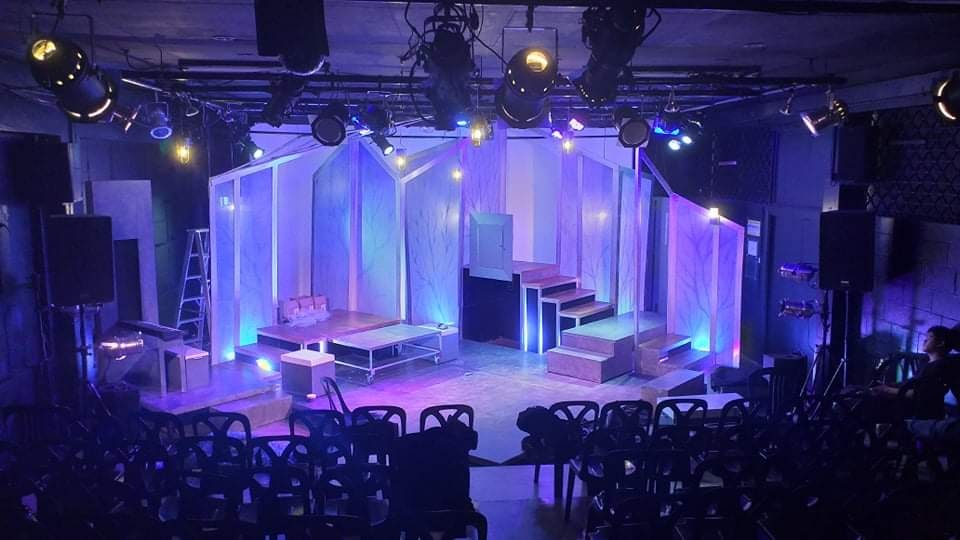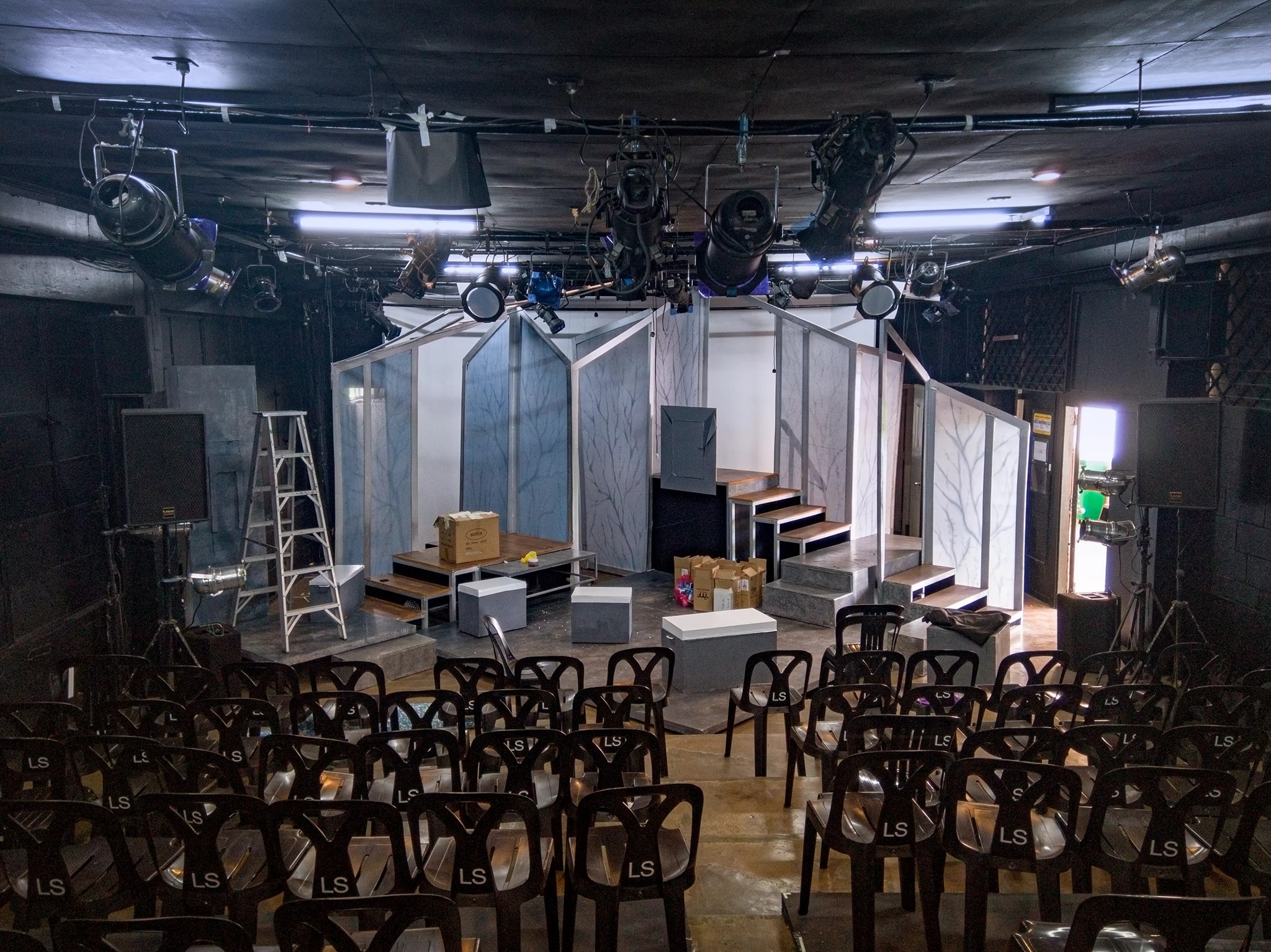SUMMARY
This is AI generated summarization, which may have errors. For context, always refer to the full article.

Almost exactly a year ago, I bowed for the last time on stage without knowing it.
We just finished the Sunday matinee show of Ateneo Blue Repertory’s Next to Normal. It was the end of the first week of a three-week sold-out run – a rarity in theater. We collected our clothes for washing, cleared the theater for the afternoon, and went to Samgyupsalamat to celebrate. As we waited for things to cook, we discussed performance notes, rehearsal schedules, and all of the other productions happening around Metro Manila that we wanted to see.
The tight-knit community of artists was no longer competing for a singular spotlight. We had all forged spaces for ourselves where we could shine. Community theater groups were sprouting all over the country, and productions were starting to get budgets. Talented young actors were being given more roles in major productions, and more opportunities for workshops were springing up in the Metro. It was the first time in a long time that there was a collective momentum that we were all riding; an industry was finally starting to form.
But the following day, a public service announcement halted that.
Then, the waiting began.
Time check
Much like the rest of the world, theater was ill-equipped to handle this degree of disruption.
“I think no one was devastated about the early closing of Dekada ’70 because we all assumed we would return and mount another two weeks of shows within a month or two,” says theater actress and playwright Sabrina Basilio.
“We didn’t know that on the day we packed up our clothes and sang “Muling Iinog Ang Mundo,” as we watched the crew dismantle our set, it was the last time we’d be together for a long time. The world didn’t move for a while after that.”
Many shows were forced to close; some weren’t even lucky enough to experience an audience. Months of hard work remained unseen except by the privileged few who caught earlier shows or were present during invite-only technical dress rehearsals. When Broadway, the symbol of New York resilience, announced that it too was closing indefinitely because of the pandemic, it hit how serious this was.
Many performers from the provinces stayed in Manila in the hopes that the lockdown would last briefly. Productions discussed the possibility of professionally filming the shows once the quarantine was lifted. We had been slowly trying to accept that the audiences wouldn’t be able to see the show as we had initially hoped. But recordings would’ve been an avenue to share the art while minimizing losses.


Company call
The government response wasn’t getting better, and the cases continued to rise. When the initial two-week lockdown turned into a month, the process of grief set in motion. People began organizing workshops, improv sessions, and educational situationers to help collect donations for frontline workers. But these were also a way to distract from what seemed inevitable.
With the end of the lockdown nowhere in sight, theater artists began helping each other as they always do.
Production teams have always recorded copies of performances for production books and, in some cases, to make potential re-runs easier. Some productions were lucky enough to be filmed before the pandemic, and they were slowly released to the public to raise money for displaced freelancers, alongside the data gathering on the creatives community by #CreativeAidPH.
Finally, Tanghalang Pilipino’s Batang Mujahideen could be seen by audiences from the comfort of their homes. Theater fans seeking comfort and catharsis could revisit beloved performances from past theater productions such as Dulaang UP’s Kundiman Party or PETA’s Care Divas. But most importantly, discussions about Filipino theater – about the excellence of artists and technical workers who are involved in all aspects of the theater – were happening for the first time because it was accessible on a national level, for free.
“I remember buhay na buhay yung chat group ng cast because it felt like we were really opening a show,” says actor Phi Palmos, recalling the hours leading up to the online release of Huling El Bimbo on YouTube. The release was a fundraising effort for families stricken by the pandemic. The production enjoyed radical success overnight, amassing millions of donations, with many of its stars turning into unlikely instant celebrities.
“It really helped us during the pandemic. Streaming gave us work and that might be the best thing because everyone was struggling. Putting it in free media produced other projects for us as well,” Palmos continued.
Suddenly, theater artists had spotlights of their own, and these were ones that they could share. “We keep saying: ‘We are just the tip of the iceberg, mas maraming magaling sa amin.’ I think it highlighted Filipino theater and the talent and the discipline that these actors imbibed. I believe yun yung isa sa pinakamagandang nagawa nung streaming,” said Palmos.
But with this also came the democratization of criticism of theater. Audience development and theater education came at the price of the artists. Criticisms concerning the politics and responsibilities that came with artistry and creating original work came to the fore.
The standstill revealed important things about theater that haven’t been addressed in a long time: lack of contracts that prevent workers from decent pay and benefits, the fickle nature of freelance, and unjust practices within the different theater circles that led to some forms of abuse and mental health issues.
These were discussions that were necessary for the evolution of art and the art form. Whatever time was previously meant for performance was now dedicated to introspection. Several groups had their commitments revitalized to safeguard these freelancers. Another group, Aktor PH, was birthed to represent actors who, up until the pandemic, hadn’t been unionized, unlike in other countries.
All of these were in preparation for a theater community that would treat its members better.
Open house
It’s thrown around that theater separates itself from other art forms because of two things: space and the live aspect. Live performances couldn’t be edited for the audience, and that meant that each show was, for better or worse, different; there was always the possibility of error.
The theater was the space wherein these characters and the audience could co-exist – forming a bubble of sorts where these mistakes and miracles could happen – creating a story simultaneously independent from and wholly informed by its audience. The presence of the actors and the audience, the interaction of these energies throughout the duration of the material, was what separated theater from other visual media.
New formats of theater have emerged from the pandemic; experimental hybrids between theater and film have emerged out of necessity. A type of “Zoom theater,” evidenced by Virgin LabFest 2020, ushers in inventive uses of the medium. The success of these has created more economical but collaborative efforts, with filmed theater productions such as Khavn De La Cruz’ MAKBETAMAXIMUS: Theatre of Destruction making their debut later this year.
Student organizations have used this time to encourage members to develop creative and original work, some of which are through devising labs. In March alone, five theater groups are staging online theater productions. Other artists have found community in live streaming apps such as Kumu and Livit that allow them to create their own performances, develop their own audiences, and share their own lives on their own terms. While these may only serve as a proxy for theater, these became viable options for artists to generate income through creative expression.
Ghostlight
In early November, we were allowed to go back into Ateneo to pick up our costumes. Signup sheets were posted so that social distancing could be properly practiced. Unable to go, I saw Instagram stories of the empty theater that still held space for the set — dust gathering on the pieces as we left it, still there even after all those months, with the lights no longer ready to illuminate whoever was onstage.
“In the very brief silences between the questions and jokes [we have online], there would be the loudest unspoken question of, ‘Do you think we’d ever make it?’ And I could see it so clearly on all of our faces. I think we were quietly sharing the loss of a sense of belonging without knowing it.” said Basilio.
While closed spaces remain COVID minefields in the Philippines, theaters began reopening elsewhere. In Tokyo, Moonlight Mobile theater created socially-distanced theater formats, using cubicles and mailbox slots to allow viewers into the experience. Australia has already started opening theaters while simultaneously creating offers that could be switched to streaming daily.
Theater had survived several pandemics before this: Shakespeare was rumored to have written King Lear during the plague and MacBeth during an epidemic. Maybe theater will exist in a different form than we have come to know, but it will survive again. That is the light I walk towards.
Until then, the intermission continues. – Rappler.com

Add a comment
How does this make you feel?
There are no comments yet. Add your comment to start the conversation.